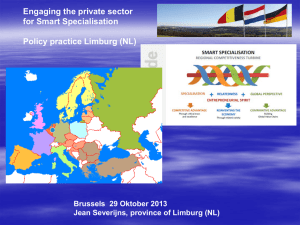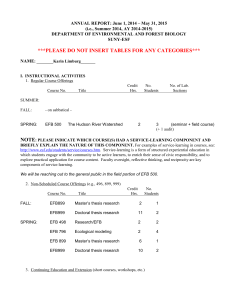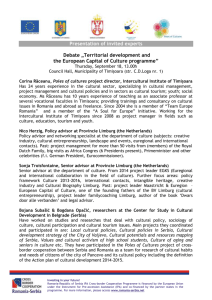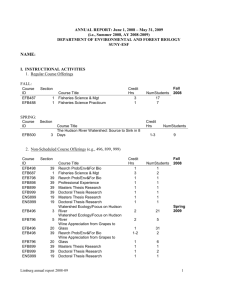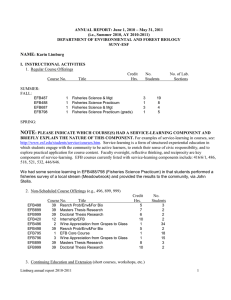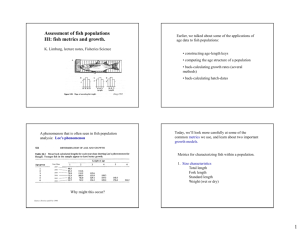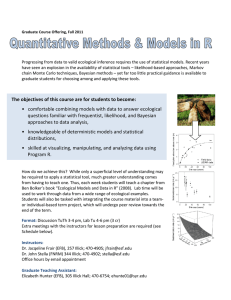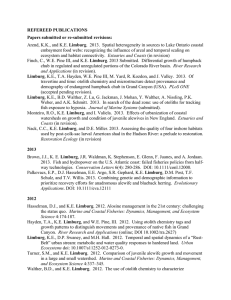ANNUAL REPORT: June 1, 2009 – May 31, 2010
advertisement
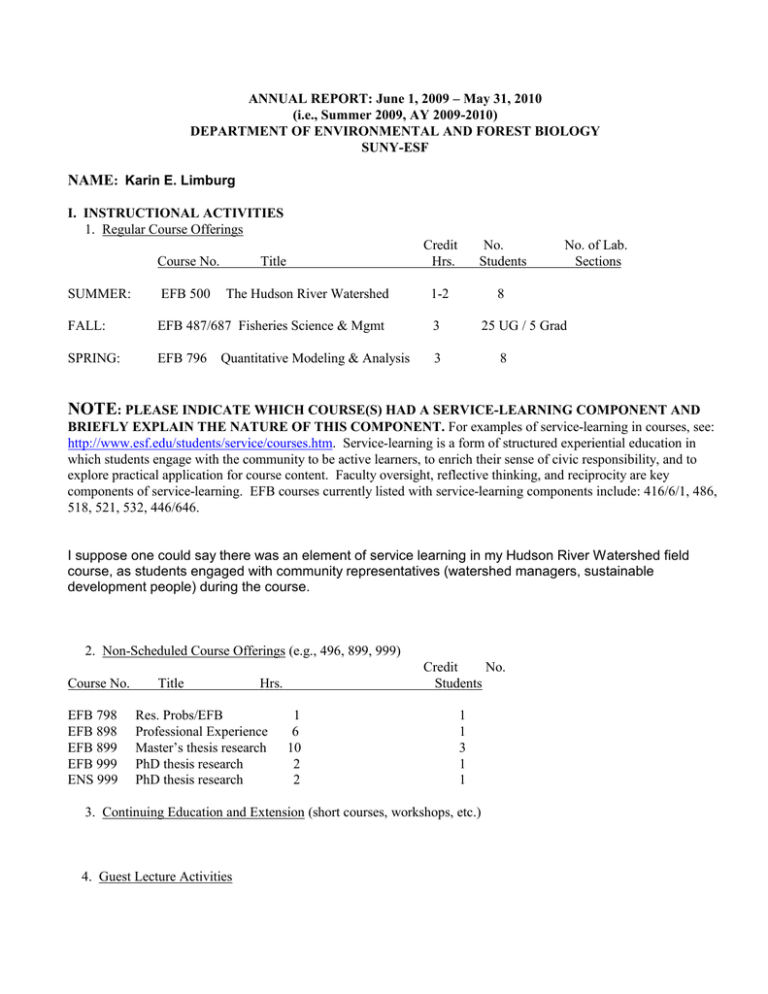
ANNUAL REPORT: June 1, 2009 – May 31, 2010 (i.e., Summer 2009, AY 2009-2010) DEPARTMENT OF ENVIRONMENTAL AND FOREST BIOLOGY SUNY-ESF NAME: Karin E. Limburg I. INSTRUCTIONAL ACTIVITIES 1. Regular Course Offerings Course No. Title The Hudson River Watershed Credit Hrs. No. Students 1-2 8 SUMMER: EFB 500 FALL: EFB 487/687 Fisheries Science & Mgmt 3 SPRING: EFB 796 3 Quantitative Modeling & Analysis No. of Lab. Sections 25 UG / 5 Grad 8 NOTE: PLEASE INDICATE WHICH COURSE(S) HAD A SERVICE-LEARNING COMPONENT AND BRIEFLY EXPLAIN THE NATURE OF THIS COMPONENT. For examples of service-learning in courses, see: http://www.esf.edu/students/service/courses.htm. Service-learning is a form of structured experiential education in which students engage with the community to be active learners, to enrich their sense of civic responsibility, and to explore practical application for course content. Faculty oversight, reflective thinking, and reciprocity are key components of service-learning. EFB courses currently listed with service-learning components include: 416/6/1, 486, 518, 521, 532, 446/646. I suppose one could say there was an element of service learning in my Hudson River Watershed field course, as students engaged with community representatives (watershed managers, sustainable development people) during the course. 2. Non-Scheduled Course Offerings (e.g., 496, 899, 999) Course No. EFB 798 EFB 898 EFB 899 EFB 999 ENS 999 Title Credit No. Students Hrs. Res. Probs/EFB Professional Experience Master’s thesis research PhD thesis research PhD thesis research 1 6 10 2 2 1 1 3 1 1 3. Continuing Education and Extension (short courses, workshops, etc.) 4. Guest Lecture Activities Course No. Title No. of Lectures EFB 423 1 Marine Ecology II. STUDENT ADVISING A. Number of undergraduates for whom you are the student’s official advisor __9__ and unofficial advisor __2 (Environmental Studies) B. Graduate Students: (Name, degree sought, starting date, month & year; if a degree was completed, please give date and full citation for the thesis or dissertation). MAJOR PROFESSOR Monteiro, Rita; PhD, began 9-2004 (passed qualifier exams, 11/07) Ramsey, Molly; PhD, began 1-2005 Sopacua, Ansye; PhD, began 9-2002 (passed qualifier exams, 12/04) defended Spring 2009: "Watershed Characterization, Management and Policy Implications: Towards a Resilient Human-Ecosystem Community with a Case Study from Krueng Aceh Watershed, Aceh, Indonesia" Degree completed February 2010 (filed e-copy of thesis). Nack, Christopher; MSc, began 9-2009 Turner, Sara; MSc, began 9-2009 CO-MAJOR PROFESSOR Boslett, Andrew; MSc, began 9-2009 Gehl, Kacie; MSc, began 9-2007, defense scheduled for 5/28/2010 Jackman, George; PhD, began 9-2008 (CUNY Queens College) MEMBER, STEERING COMMITTEE (other than those listed above) Chen, Xiaoxia; PhD (Syr. U.) Dittman, Jason; PhD (SU) (defended, Fall 2009) Eckerlin, Jessica; MSc (defended, April 2010) Guzman, Aileen; PhD (defended, April 2010) Hazell, C.J.; PhD (passed qualifier exams 2006?) Kroll, Stefanie; PhD McEwen, April; MSc (defended, April 2010) Tyszko, Steve; MSc (defended, April 2010) Watson, Cynthia; PhD - (passed qualifier exams, fall 2007) Whritenour, Cheryl; MSc (defended, April 2009) CHAIRMAN OR READER ON THESIS EXAMS, ETC. Beth Ann Arthur (Paper & Bioprocess Engineering) III. RESEARCH COMPLETED OR UNDERWAY A. Departmental Research (unsupported, boot-legged; title - % time spent) I have a non-funded collaboration with some Swedes, studying Baltic Sea cod. To date this has resulted in 1 publication and several presentations. I was also able to complete and publish the work from an expired NY Sea Grant funded project. B. 1. Grant-supported Research (source, subject, amount - total award and current year, award period starting and ending dates; list graduate research assistants supported by each grant) • Grant award, National Science Foundation: “CAREER: Watersheds and fisheries as foci of human impacts and ecological responses: a research and teaching agenda” ( 4/1/03 – 3/31/09, $600,000)’ no-cost extension. Supported 3 PhD students (A. Sopacua, R. Monteiro and M. Ramsey), 2 MSc student (K. McGohan and K. Gehl) and 3 post-docs (B. Hong, T. Elsdon, A. Lochet). • Grant award, Syracuse Center of Excellence: “An Integrated Monitoring/Modeling Framework for Assessing Human-Nature Interactions in Urbanizing Watersheds: Wappinger and Onondaga Creek Watersheds,” $299,882, 7/01/06 – 6/30/09 (no-cost extension). Supported 2 graduate students (L. Luo and K. Hyde) and a post doc (B. Hong). • Grant award, Syracuse Center of Excellence: “Bridging the Temporal Mismatch between RemotelySensed Land Use Changes and Field - Based Water Quality/Quantity,” $99,999, 8/5/08 - 7/31/09. G. Mountrakis is PI, Myrna Hall and I are co-PIs. Supported 2 graduate students (L. Luo and K. Gehl) and one post-doc (B. Hong). • In-kind grant award, Cornell High Energy Synchrotron Source (CHESS): Beam time at the synchrotron for X-ray fluorescence analyses: October 2009 (1 week) • Grant award, National Science Foundation: “MRI: Acquisition of a Laser-Ablation System for High Resolution, Micro-Scale Analysis of Environmental Materials,” $202,929, 7/01/07 – 6/30/10. This is an equipment grant, and can’t support anyone. • Grant award, NOAA: “Effects of Land Use on Alewife Growth Rates and Recruitment Using Biogeochemical Tracers in New England,” $60,000, 3/3/07 - 5/31/10. This is supporting one grad student (R. Monteiro, who wrote the grant). • Grant award, NOAA: “Habitat Use by American Shad Larvae in the Hudson River Estuary, New York,” $40,000, 5/01/10 – 5/31/12. Supports one grad student (C. Nack, who co-wrote the grant). • Grant award, Hudson River Foundation: “Geochemical Markers in Otoliths to Aid in Stock Identification and Conservation of River Herring,” $184,660, 6/1/09 – 5/31/11. Supports 1 grad student (S. Turner) and one summer intern (M. Payne) • Grant award, National Science Foundation: “Positioning Rust Belt Cities for a Sustainable Future: A Systems Approach to Enhancing Urban Quality of Life,” (D. Nowak and M. Hall, PIs), $300,000, 1/1/10 – 12/31/11. One of my students (A. Boslett) is an un-funded participant in the project. • Grant award, USGS (via U. Florida): “Near Shore Fish Ecology in the Grand Canyon,” 4 years, $1,178,711 total, $272,976 to ESF. Role: co-PI, but PI at ESF. Supports one post-doc (T. Hayden). • Grant award, SUNY: “Source to Sink: a Conversation in the Disciplines about Explanding the Research and Education Corridor in the Hudson River Watershed,” (with S. McNulty), $5,000. 2. Research Proposals pending (include information as in B.1., above). • Proposal (just notified we will be funded) to National Fish and Wildlife Foundation, “Determining Origins of River Herring Bycatch,” total $428,401 to a group, of which ESF will receive $187,137. This will support a doctoral student and summer student field assistants. 3 years. • Pre-proposal to National Science Foundation: “IGERT: ‘Helping Forests Walk’: Engaging Scientific and Traditional Ecological Knowledge to Build Resilience in Cultural Landscapes Facing Environmental Change” (Robin Kimmerer, PI; 60 months) • Proposal to Grand Canyon Monitoring and Research Center: “Validating of δ13C and δ18O otolith chemistry signatures of resident Little Colorado River fish using secondary ion mass spectrometry” (ca. $60,000). • Additionally, I am engaged in research proposals to Scandinavian research agencies (one Danish, one Swedish), for proposed work on fish otoliths. 3. Research Proposals submitted, but rejected (include information as in B.1, above) • Proposal to National Science Foundation: “IGERT: ‘Helping Forests Walk’: Engaging Scientific and Traditional Ecological Knowledge to Build Resilience in Cultural Landscapes Facing Environmental Change” (Robin Kimmerer, PI), $3,199,901, 60 months. • US Environmental Protection Agency: “Managing Agriculture Systems for Ecosystem Services: Coupling Watershed Regulating Services with Freshwater and Estuarine Services in the AlbemarlePamlico Basin, USA,” $500,000, 1/1/2010-12/31/12. Colin Beier is PI, I am co-PI. • Proposal to National Science Foundation (Coupled Natural and Human Systems), “Collaborative research: Bioenergy and resilience in the northern hardwood forest,” (Peter Groffman, Cary Inst of Ecosystem Studies, PI), $299, 352 to ESF (of a total $1,496,135), 5 years. IV. PUBLICATIONS (Full bibliographic citation, i.e., do not use "with Jones," or "Jones, et al."; please list only publications published, in press, or actually submitted during this reporting period --- do not list manuscripts in preparation). A. Refereed Publications Limburg, K.E., and J. R. Waldman. 2009. Dramatic declines in North Atlantic diadromous fishes. BioScience 59: 955-965. Limburg, K.E., and M. Elfman. 2010. Magnitude and patterns of Zn in otoliths support the recent phylogenetic typology of Salmoniformes and their sister groups. Canadian Journal of Fisheries and Aquatic Sciences 67(4): 597-604. Limburg, K.E., V. Luzadis, M.M. Ramsey*, K.L. Schulz, and C.M. Mayer. 2010. The good, the bad, and the algae: ecosystem services and disservices generated by zebra and quagga mussels. Journal of Great Lakes Research 36: 86-92. Limburg, K.E., H. Høie, and D.S. Dale. (in press) Bromine patterns in Norwegian coastal cod otoliths – a possible marker for distinguishing stocks? Environmental Biology of Fishes Limburg, K.E., A. Lochet♣, D. Driscoll, D.S. Dale, and R. Huang. (in press) Selenium detected in fish otoliths: a novel tracer for a polluted lake? Environmental Biology of Fishes Svedäng, H., C. André, P. Jonsson, M. Elfman, and K.E. Limburg. (in press) Homing behaviour and otolith chemistry suggest fine-scale sub-population structure within a genetically homogenous Atlantic cod population. Environmental Biology of Fishes Daniels, R.A., R.E. Schmidt, and K.E. Limburg. Hudson River fisheries: vast to dwindling in 400 years. In R.E. Henshaw, editor. Environmental History: Human Uses that Changed Ecology; Ecology that Changed Human Uses. SUNY Press. (revised, currently in re-review) Lochet, A♣., K.E. Limburg, L. Rudstam, M. Montesdeoca. 2010. Selenium in fish otoliths: effects of selenium and mercury from the water. Canadian Journal of Fisheries and Aquatic Sciences (accepted pending revision). Pace, M.L., S.E. Hampton, K.E. Limburg, E.M. Bennett, E.M. Cook, J.M. Grove, K.Y. Kaneshiro, S.L. LaDeau, G.E. Likens, D.McKnight, D.C. Richardson, D.L. Strayer. 2010. Individual ecologists: opportunities and rewards for engaging with environmental issues. Frontiers in Ecology and Environment (re-submitted following revision). Sopacua, J.A*., C.N. Kroll, and K.E. Limburg. Spatial analysis of saltwater intrusion and groundwater vulnerability in coastal Krueng Aceh Watershed, Banda Aceh, Indonesia. International Journal of Water Resources Management (in review) * = student author; ♣ = post-doc author B. Non-refereed Publications Costanza, R., and K. Limburg. 2010. The Ecological Economics Review: an introduction to the inaugural issue. Ecological Economics Review 1 :vii-viii. Gren, I.-M., and K.E. Limburg. 2010 (in press). Nutrient recycling and waste treatment from estuarine and coastal systems. To appear in Ecological Economics of Estuaries and Coasts (M. van den Belt and R. Costanza, editors). Limburg, K.E. 2010. The Hudson River watershed: source to sink in eight days. The Spruce Moose, Spring 2010. Breitburg, D., L. Davias, K. Limburg, and D. Swaney. 2010. Linking Nutrients, Hypoxia, Fisheries, and Fishes: Report from a Workshop. LOICZ INPRINT newsletter. C. Papers Presented at Science Meetings (give title, date, occasion, and location) Limburg KE, and JR Waldman. Dramatic declines in North Atlantic diadromous fishes. Oral presentation, US Society for Ecological Economics Biennial Conference, June 2009, Washington, DC. Limburg KE, V Luzadis, M Ramsey*, C Mayer, and K Schulz. The good, the bad, and the algae: ecosystem services and disservices of dreissenid mussels. Poster presentation, US Society for Ecological Economics Biennial Conference, June 2009, Washington, DC. Limburg KE. Apples and oranges, selenium and barium: what can be learned about otolith chemistry from comparing different analytical techniques. Oral presentation, 4th International Otolith Symposium, August 2009, Monterey, CA. Limburg KE, Dale D, Høie H, Olson C*, and Walther Y. Modern and Neolithic Baltic Sea cod otolith chemistry: potential to track juvenile habitat use and other life history parameters. Oral presentation, 4th International Otolith Symposium, August 2009, Monterey, CA. Limburg KE, and B Hong. OtoGIS: a new way to analyze otolith multivariate data. Poster presentation, 4th International Otolith Symposium, August 2009, Monterey, CA. Limburg KE, A Lochet♣, D Dale, and D Driscoll. Where does the Selenium come from? A geographic survey of Central New York to determine the source of Selenium discovered in otoliths. Poster presentation, 4th International Otolith Symposium, August 2009, Monterey, CA. Limburg KE and M Elfman. Oscillatory patterns of Zn in otoliths support a recent phylogenetic typology of Salmoniformes and their sister groups. Poster presentation, 4th International Otolith Symposium, August 2009, Monterey, CA. Lochet, A♣, KE Limburg, and D Dale. Effects of Mercury on Selenium incorporation into fish otoliths. Oral presentation, 4th International Otolith Symposium, August 2009, Monterey, CA. Hayden T♣, KE Limburg, WB Pine III, and T Frazer. Humpback chub: resolving site-specific otolith markers in the Grand Canyon. Poster presentation, 4th International Otolith Symposium, August 2009, Monterey, CA. Limburg KE. The Polgar Fellowship Program: (some) pathways of progress, and "grand challenges" for the next quarter century. Keynote presentation, 25th Anniversary of the T.T. Polgar Fellowship Program, Cary Institute of Ecosystem Studies, Millbrook, NY, September 2009. Monteiro R*, I Valiela, and KE Limburg. Effects of land use on alewife growth rates using biogeochemical tracers in New England estuaries. Oral Presentation, Coastal and Estuarine Research Federation Biennial Conference, Portland, OR, November 2009. Limburg KE, V Luzadis, M Ramsey*, C Mayer, and K Schulz. The Good, the Bad and the Algae: Ecosystem services and disservices generated by invasive zebra and quagga mussels. Oral Presentation, Coastal and Estuarine Research Federation Biennial Conference, Portland, OR, November 2009. Ramsey MM*, KE Limburg, and V Luzadis. Quantifying the Ecosystem services of open space areas in the Moodna Creek watershed: A tool for sustainable watershed management. Ecological Society of America Millennium Conference: Water-Ecosystem Services, Drought, and Environmental Justice, Atlanta, GA, November 2009. Limburg KE and T Hayden. Use of otolith chemistry to reconstruct the lives of fishes. Oral presentation, Annual Meeting, Grand Canyon Research and Monitoring, Cedar Key, FL, March 2010. Hayden T♣, KE Limburg, W Pine. Otolith chemistry as biomarkers of life history in endangered humpback chub in the Colorado River, Grand Canyon. Oral presentation, Annual Meeting, Grand Canyon Research and Monitoring, Cedar Key, FL, March 2010. Limburg KE. Aquatic ecosystem services: a useful paradigm for limnologists? Keynote presentation, Annual meeting of , Groupe de Recherche Interuniversitaire en Limnologie et en Environnement Aquatique (GRIL), Montreal, March 2010. Limburg KE. Review of otolith chemistry and how it can be applied to assess resilience of diadromous species. Oral presentation, workshop on Resilience in Diadromous Species Populations, University of Maine at Orono, April 2010. Turner SM*, KE Limburg, SR Thorrold, JR Waldman. Determination of river herring natal origin by otolith microchemical markers. Oral presentation, 66th Annual Northeast Fish and Wildlife Conference, Newton, MA, April 2010. Limburg KE, Dale D, Høie H, Olson C*, and Walther Y. Modern and Neolithic Baltic Sea cod otolith chemistry: potential to track juvenile habitat use and other life history parameters. Oral presentation, 66th Annual Northeast Fish and Wildlife Conference, Newton, MA, April 2010. * = student author; ♣ = post-doc author D. Public Service Presentations (lectures, seminars, etc. to and for the public; give group or occasion, date(s), and attendance) Presented to and answered questions from the general public about anadromous fishes at “Hudson River Day,” Hudson River National Estuarine Research Reserve at Norrie Point State Park, Staatsburg, NY, Sept 12, 2009. V. PUBLIC SERVICE A. Funded Service (include consulting activities) 1. Government Agencies (Federal, State, Local): 2. Industrial and Commercial Groups, etc. B. Unfunded Service to Governmental Agencies, Public Interest Groups, etc. Member, Fisheries Subcommittee, Hudson River Estuary Management Advisory Committee. We met twice (December 2009 and April 2010) to discuss fisheries closures and other matters. VI. PROFESSIONAL DEVELOPMENT A. Professional Honors and Awards (for teaching, research, outreach, etc.) SUNY-ESF Exemplary Researcher Award, 2010 B. 1. Activities in Professional Organizations (offices held, service as chairman, member, participant or consultant) Finished out my term (in June 2009) as Past President of the US Society for Ecological Economics 2. Professional Society Membership • American Fisheries Society • American Institute of Biological Sciences • American Society of Limnology and Oceanography • Coastal and Estuarine Research Federation (currently running for Governing Board) • Ecological Economics (both the International and U.S. chapters) • Ecological Society of America • Hudson River Environmental Society 3. Other Professional Activities a. Editorial activity Journal (s) Responsibility • Ecology and Society Subject editor • Ecological Economics Reviews Founding editor (with Robert Costanza) Other (books, symposia, etc.) b. Reviewer Journal(s) No. of manuscripts BioScience Canadian J. Fish. Aquat. Sci. Ecology and Society (shepherding reviews) Ecological Applications Ecological Economics Environmental Biology of Fishes Environmental Management Journal of Applied Ichthyology Journal of Great Lakes Research Marine Ecology Progress Series Solutions Transactions of the American Fisheries Society Agency National Science Foundation No. of proposals 2 Other Hudson River Foundation 6 1 1 3 1 1 2 1 1 2 2 1 1 Council for Endangered Species Act Reliability (reviewed a proposal to list the American eel (Anguilla rostrata) as Endangered under the Endangered Species Act) c. Participation (workshops, symposia, etc.) Name of workshop, etc. Date Place • “First workshop of the Diadromous Species Research Restoration Network,” University of Maine at Orono, July 2009 • “Nitrogen, Hypoxia and Fishes: Moving Beyond Fisheries Data to Understand Effects on Upper Trophic Levels in Estuaries and Semi-Enclosed Seas” – co-organized with Denise Breitburg (Smithsonian Research Institution) and Dennis Swaney (Cornell), Smithsonian Research Institution, Edgewater, MD, September 2009 • “Quantification and Valuation of Ecosystem Services – a SUNY Conversation in the Disciplines,” Nov. 23, 2009 • “Grand Canyon Food Web Ecology and Modeling,” Cedar Key, FL, March 2-4, 2010 • “Workshop to re-invent the GRIL (Province of Quebec Inter-University Group for Limnological Research),” Montreal, March 5-6, 2010 • “Resilience of North Atlantic Diadromous Fish Assemblages: a Restoration Perspective”, April 1-2, 2010, University of Maine at Orono C. Further Education/Re-training Undertaken, Leaves, Workshops, etc. D. Foreign Travel (Where, When, Purpose) • Montreal, Canada in March 2010; attend workshop mentioned above. Made keynote presentation. VII. ADMINISTRATIVE AND SERVICE RESPONSIBILITIES (include committee participation) A. Department-level • Chair, Graduate Program Advisory Committee • Member, Building and Space Committee • Member, Wildlife Biologist Search Committee B. College-level C. University-wide, including Research Foundation VIII. SUMMARY OF SIGNIFICANT ACTIVITIES AND ACCOMPLISHMENTS DURING THIS REPORTING PERIOD, ESPECIALLY THOSE MOST NOTEWORTHY AND RELATIVE TO THE COLLEGE’S AND DEPARTMENT’S MISSION. One paragraph on each of the following would be most helpful: this past year, what have you done for our students, department/college, and self professionally? NOTE: The information in this section (along with the supporting specific information elsewhere in this report) should be your strongest case for being considered for a discretionary raise, which I’ll continue to award based on your contributions to the department and college this reporting period. What I’ve done for students (and others) this past year: I had a new cohort of graduate students enter, along with a new post-doc. I felt that I did a better job than in previous years in terms of building some cohesion. I worked with the three new MSc students to develop research proposals, and have tried to involve them in other aspects of professional work such as reviewing manuscripts. All of them submitted proposals for funding their research, and one of them was successful. I have found that post-docs can be extremely helpful in mentoring, as they bridge between the grad school experience and the next career step. Hence, it has been a pleasure to work with this group. I was also able to provide research experience for some undergraduates in my lab (otolith research, a topic that requires stamina). I’ve also continued to mentor my doctoral students, one of whom (A. Sopacua) finished her dissertation revisions and took a job with UNICEF back in her home country of Indonesia, as a water resources expert. In terms of teaching, the Fisheries course had a record number of enrollees. I think this was due to the bad economy last year, which stimulated greater attendance in school. But the course went well, and reviews were good. In the springtime, I decided to teach a graduate level course, “Quantitative Modeling and Analysis.” I piloted the use of a textbook that introduced many complex topics, but that worked examples explicitly in Excel. I liked this approach, as I think it was pretty accessible for the students. I’ll note that most of the students in this course are not the type who ordinarily leap at modeling classes; and in fact, my intent was to reach this audience. Given that this was the first time through, it was fairly successful. I judge that by the fact that all the students successfully taught parts of the book, all are now at least somewhat conversant in parameter estimation and Monte Carlo, Bayesian, and other analysis, and the student projects were in general quite good. I think at least two of them have a good chance of being expanded into publications. I also organized the call for nominations for the EFB Outstanding Doctoral Student award, and was pleased that we had an awardee this year (this is not always the case). What I’ve done for the department and college this year: Along with this last point, I continued to chair the EFB Graduate Program Advisory Committee (GPAC) and served on two other committees. Our GPAC developed a new core course for incoming grad students, and it was run in both semesters by John Farrell and Kim Schulz, who did a remarkable job getting this off the ground. With Valerie Luzadis (lead PI) and Greg Boyer, I obtained funding for and helped to run a SUNY “Conversations in the Discipline” (CID) workshop on ecosystem services. It brought in around 60 people from as far away as Canada, and was quite successful as these things go. It helps to draw attention to the fact that SUNY ESF has strengths in this transdisciplinary arena. I’ve also written another CID proposal with Stacy McNulty of the Adirondack Ecological Center, for which we’ve received funding for a workshop to expand the research and education networks within the Hudson River watershed. Although there is an active network, it has largely ignored the Upper Hudson and the Mohawk Valley, areas where SUNY ESF can – and does – play an important role. Our workshop will be held at Huntington in early October. We anticipate hosting 40-60 participants. What I’ve done for me: Over the last year or two I’ve gotten involved in some new research networks, and this has been both exciting and has led to new collaborations and research funding. The research areas include the restoration of ecosystems for diadromous (land-sea migrating) fishes, identification and management of marine bycatch of river herring (actually, two species of land-sea migrating herrings), and the joint interaction of watershed nutrient loadings and fisheries on the generation and persistence of marine hypoxia. These are in addition to ongoing research in the Hudson River estuary, Baltic Sea, and Grand Canyon. As is often the case, it is possible to use teaching to gain further expertise. This was part of my motivation to teach “Quantitative Modeling and Analysis.” It was a good refresher and also a chance to learn more up to date methodologies, in order to be a better teacher and practitioner. I hope to expand on this as a grad-level course to be run every other spring, alternating with a grad-level course in grant proposal writing. The other ongoing themes in my research program continue to evolve. IX. A. FUTURE PLANS, AMBITIONS, AND POTENTIAL CONTRIBUTIONS FOR YOUR OWN PROFESSIONAL DEVELOPMENT AND THE ENHANCEMENT OF THE PROGRAM IN ENVIRONMENTAL AND FOREST BIOLOGY (brief summary) I plan to continue my current research and teaching directions, as they seem strong and exciting to me. I am reasonably sure that the hypoxia research will lead to a paper or two in a moderately to very prominent journal. I have also been asked, and said yes to, becoming an Associate Editor at Frontiers in Ecology and Environment. I am also going to work with the Editor of the Journal of the North American Benthological Society to develop a special issue section on ecological economics. Finally, I have requested to be reviewed for promotion to Full Professor, so that process has begun. B. PROJECTED ACTIVITIES FOR NEXT YEAR 1. Summer 2010 a. Course(s) to be offered b. Proposed research activity • River herring, Baltic cod, and Grand Canyon fishes. • Participate in NSF-ULTRA research in Onondaga Creek. • Write review article on otolith chemistry, and write research papers • Write book chapters for Urban Ecology textbook c. University, professional society, and public service As described above 2. Fall Semester 2009 a. Course(s) to be offered EFB 487/687 Fisheries Science & Management EFB 488 Fisheries Science Practicum b. Proposed research activity As described above, re-write and re-submit grant proposals c. University, Professional society, and public service As described above 3. Spring Semester 2010 a. Course(s) to be offered Grant Writing and Management Wine Appreciation from Grapes to Glass b. Proposed research activity As described above c. University, professional society, and public service As described above
